Sorted by date Results 26 - 50 of 155

The two legendary visionaries who conceived the 1,049-mile race from Anchorage to Nome hardly could have imagined the success and changes that would happen over the next half century of the "Last Great Race." In 1964, a history buff who lived in Wasilla had an idea. Dorothy Page, secretary of the Aurora Dog Mushers Club, saw that snowmachines were fast taking the place of dog teams and mushing. She thought a sled dog race on the historic Iditarod Trail, which originally began in Seward during...

Following the Japanese attacks on Pearl Harbor on Dec. 7, 1941, and six months later at Kiska and Attu, wartime hysteria and fear of sabotage and espionage ran rampant across the country. President Franklin D. Roosevelt signed Executive Order 9066 in February 1942. It ordered the removal of more than 112,000 Japanese Americans – also called Nikkei-from the West Coast. Those with Japanese ancestry were taken from their homes, businesses and schools and put in internment camps. Alaskans were n...

A little "two-by-four" island, a couple of miles off the city of Kodiak, has several Alaska firsts. The first horses in Alaska were brought here, the first road constructed, the Territory's first iron rails put in, and the first field of oats was sown: all to support a sawmill. The sawmill established on Woody Island was perhaps unique in commercial enterprises because its main product was sawdust. And the sawmill, the iron rails, Alaska's first road, and first horses were the result of what...
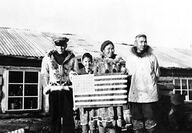
When the U.S. Government needed them, Alaska's Native population came out in droves. From the beaches of Bristol Bay to the far corners of Bethel, Kotzebue and Barrow, villagers didn't hesitate to provide Alaska with a line of defense after the Japanese bombed Pearl Harbor on Dec. 7, 1941. Col. Marvin "Muktuk" Marston, who'd been put in charge of organizing the Alaska Territorial Guard, traveled along 5,200 miles of western Alaska coastline to personally address the Natives, including a stop in...
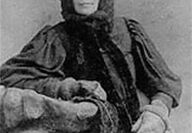
Many adventurous souls headed north during the 1890s after prospectors first discovered coarse placer gold in the Yukon River basin on Fortymile River. But a widowed German immigrant who traveled that arduous route was in search of something much more precious: her son. Anna DeGraf, who lost her husband in the West many years before, climbed the Chilkoot Trail in 1894 at the age of 55. She hoped to find her youngest son, George, who'd left Seattle for the gold-filled Yukon region a few years...

Fire was the curse of many towns during the Klondike Gold Rush era, and Dawson was no exception. The extreme cold, coupled with dryness, meant fires burned in all buildings when occupied. Stovepipes thrust through flimsy walls or roofs of cabins and tents carried smoke from high-creosote spruce. Over time, the creosote built up on the pipes, which increased the draft, and soon that created enough heat to start the creosote burning. Eventually, a red-hot stovepipe could set a building on fire....
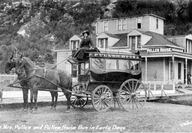
Harriet Smith Pullen left her children with friends in Seattle, and a bankrupt farm in Cape Flattery, and arrived broke in Skagway on Sept. 8, 1897. Although husband Daniel came with her, their marriage ended after he continued on to the Klondike and later died in Seattle in 1910. Earning $3 a day (about $108 in 2023 dollars) as a cook for Capt. William Moore, one of Skagway's founders, the enterprising 37-year-old soon opened a tent restaurant to feed Skagway's hungry stampeeders. She also...

Before he became well-known around the country, one of America's most famous prison inmates dug gold nuggets out of a mine in Juneau during 1908. But justice proved swift and sure after he killed a man on Jan. 18, 1909. A coroner's jury convened the evening of the murder, and after hearing testimony from the various parties, returned its verdict that Charles F. Damer met his death at the hands of the rival suitor for the affections of a woman named Kitty O'Brien. The jury included O'Brien as an...

If you have ever traveled to Seattle you may have visited its iconic Pioneer Square, which once was the heart of the Washington city. During the Klondike Gold Rush of the late 1890s, Seattle was the center for travel to Alaska. A group of businessmen decided it would be a great idea to connect Seattle's city center to its neighbor to the north by displaying an icon that was uniquely tied to Native culture. Their plan included enlisting one of the most well-known steamships of the day and a bit...

Thousands of gold seekers flooded into the North country during the late 1800s and settled around new towns such as Nome, Juneau and Dawson. Several also streamed into Cook Inlet. They hacked out primitive trails connecting scattered camps and eventually unified the region between Cook Inlet on the south and the Talkeetna Mountains on the north, and the Matanuska River on the east and the Susitna River in the west. Although few of the prospectors who entered Cook Inlet became rich, by the early...

This coming Memorial Day, it seems fitting to honor the sacrifice that America's brave military made in the Aleutians 80 years ago this month. Under the mistaken belief the Doolittle Raiders had taken off from an air base in the Aleutian chain to bomb Tokyo during spring 1942, Japanese forces bombed Dutch Harbor two months later. They then proceeded to occupy the islands of Kiska and Attu, although most Americans had no idea the enemy was entrenched on our soil – no enemy had occupied A...
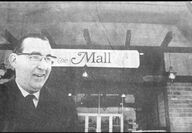
Have you ever wondered how the mall that sits at Northern Lights Boulevard and the New Seward Highway got its start? This Anchorage landmark opened its doors to the public for the first time 55 years ago. When shoppers streamed into The Mall, then Alaska's largest shopping center, on Jan. 31, 1968, they found a covered, weather-conditioned facility anchored by Sears Roebuck Company at one end and the newest Carr's Quality Food Center at the other. The Mall was the brainchild of Lawrence J....
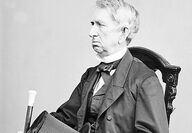
On March 30, 1867, U.S. Secretary of State William H. Seward and Russian minister to the United States Edouard de Stoeckl exchanged copies of the Treaty of Cession, whereby America agreed to pay Russia $7.2 million for the territory of Alaska. The formal transfer of the territory did not happen until several months later, but Seward had been wanting Alaska for years before he finally succeeded in obtaining it. "Standing here and looking far off into the northwest, I see the Russian as he busily...

After brief stints in Skagway and Whitehorse, one Kansas girl swirled her way into gold rush history when she stepped on stage at the Palace Grand in Dawson City in 1900. Kathleen Eloisa Rockwell, better known as "Klondike Kate," delighted audiences of miners with her song-and-dance routines. She wore an elaborate dress covered in red sequins and an enormous cape in one dance that made her famous. Kate would take the cape off and start leaping and twirling with a cane that had yards of red...
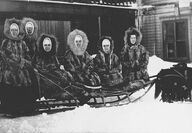
Many images come to mind when one thinks of gold rush days in Alaska: bearded prospectors swishing pans filled with water as they search for specks of gold; saloons beckoning the hardworking boys to forget all their troubles with a slug of whisky and a game of chance; and ladies known as "Lil" leaning against pianos, offering to help miners lighten their leather pokes. An image that doesn't usually come to mind is that of four nuns mingling with the masses on the virtually lawless streets of...

Some adventurous souls who came to Alaska didn't search the creek beds and mountains for golden riches. Instead they chose to make their fortunes through trapping furs. From early in the fall to the close of trapping season in April, many trappers traveled miles and miles of trap lines with no company but that of their dogs. It was no job for a "Chechako." Trappers like Ed Ueeck covered around 80 miles a week, checking to see if any animals had been caught in hidden traps. "About 14 miles a day...

As hordes of prospectors streamed into Alaska and Canada in the 1880s and 1890s, crime like thefts and claim jumping became more common. The Canadians had not yet established a law and order presence in their remote territory and the Americans' only established civil government was hundreds of miles away in Sitka. In 1893, miners in the camp of Fortymile formed the fraternal Yukon Order of Pioneers to enforce correct moral behavior. The order's motto was "Do unto others as you would be done...
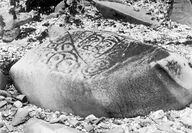
Not only does Alaska have a history steeped in fur trading, whale harvesting and gold mining. It also has drawings on rocks usually associated with primitive people in exotic faraway lands. Petroglyphs, the Greek word for rock carvings, are among many enigmas of science. Because their true meanings are elusive, they remain a mysterious link to a people who inhabited the world a long time ago. Many of Alaska's petroglyphs, which are in abundance in the Southeastern part of the state, are unique...
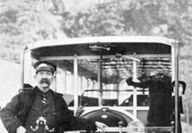
A three-hour stopover in Skagway in July 1923 by President Warren G. Harding turned into a booming business for one Alaskan sourdough. Martin Itjen, an immigrant who came north from Florida in 1898 to join the stampede in search of riches in the Klondike, took the President on an excursion in a painted coal truck. After seeing how much Harding enjoyed the tour, the mustached Itjen figured he could make a living off tourism in the famous gold rush city and started the Skagway Streetcar Co. The...

When Land Office chief Andrew Christensen opened the auction for townsites above Ship Creek on July 10, 1915, bidding became so brisk that prospective lot owners couldn't hold down prices. After sales closed a week later, 655 lots had sold for almost $150,000 (more than $4 million in today's dollars). Christensen claimed the sale had "injected confidence in the people of the town" that soon would become Anchorage. But that confidence may have been tempered somewhat when the residents realized th...
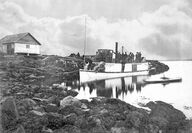
Some courageous pioneers saw the possibilities of the Yukon Basin years before the Klondike Gold Rush. And a few stand out above the rest, including Leroy Napoleon "Jack" McQuesten, Alfred Mayo and Arthur Harper. Had they not seen the need to establish supply centers, it is possible that gold rushes to the Yukon and Alaska would not have boomed during the late 1890s. These men met up in British Columbia in 1873 and continued on to Fort Yukon together. The first winter, Harper went prospecting...
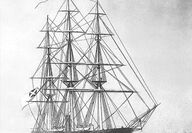
Seventy-four days after Gen. Robert E. Lee surrendered his Confederate forces at the Appomattox courthouse in Virginia, and almost two months after the Confederate Army stopped fighting on land, the last gun of the Civil War was fired in the Bering Sea of Alaska. Not knowing the war had ended, the commander of English-built Confederate vessel CSS Shenandoah fired upon several whalers near Saint Lawrence Island on June 22, 1865 (although some credible sources say it was on June 28). Commanding of...
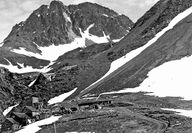
As news of gold spread through America in the mid-1890s, hundreds of people flooded onto Seattle docks seeking transportation northward. Among the 100 passengers who packed onto the Cook Inlet-bound steamship Utopia was a man whose name would become synonymous with an Alaska ski resort. James E. Girdwood traveled to Kachemak Bay in early May 1896, where he hopped aboard the small steamer L.J. Perry, run by "Cap" Austin E. Lathrop. Girdwood made his way through the ice-filled Cook Inlet to...
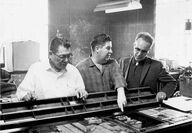
In 1911, near the village of Tikigaq, Howard Rock's shaman grandmother predicted he would become a great man. More than 50 years later, the prophecy came true. Rock, small in stature, did indeed become a giant among men. Raised in the traditional Eskimo way, Rock learned to hunt with his father and embraced his culture. But he also had a foot in the western world. Like many Native children of the time, Rock had to leave his village at the age of 15 to continue his education past the eighth...
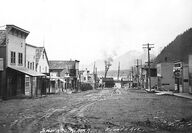
In March, Alaskans celebrate Seward's Day in honor of the man who succeeded in persuading the United States to buy Alaska from the Russians. And there are many landmarks named after President Lincoln's Secretary of State William Henry Seward. However, when Seward was chosen for the name of the town on Resurrection Bay, it took the personal intervention of President Theodore "Teddy" Roosevelt to make it possible. By 1902, John Ballaine, originator and promoter of the Alaska Central Railway and...